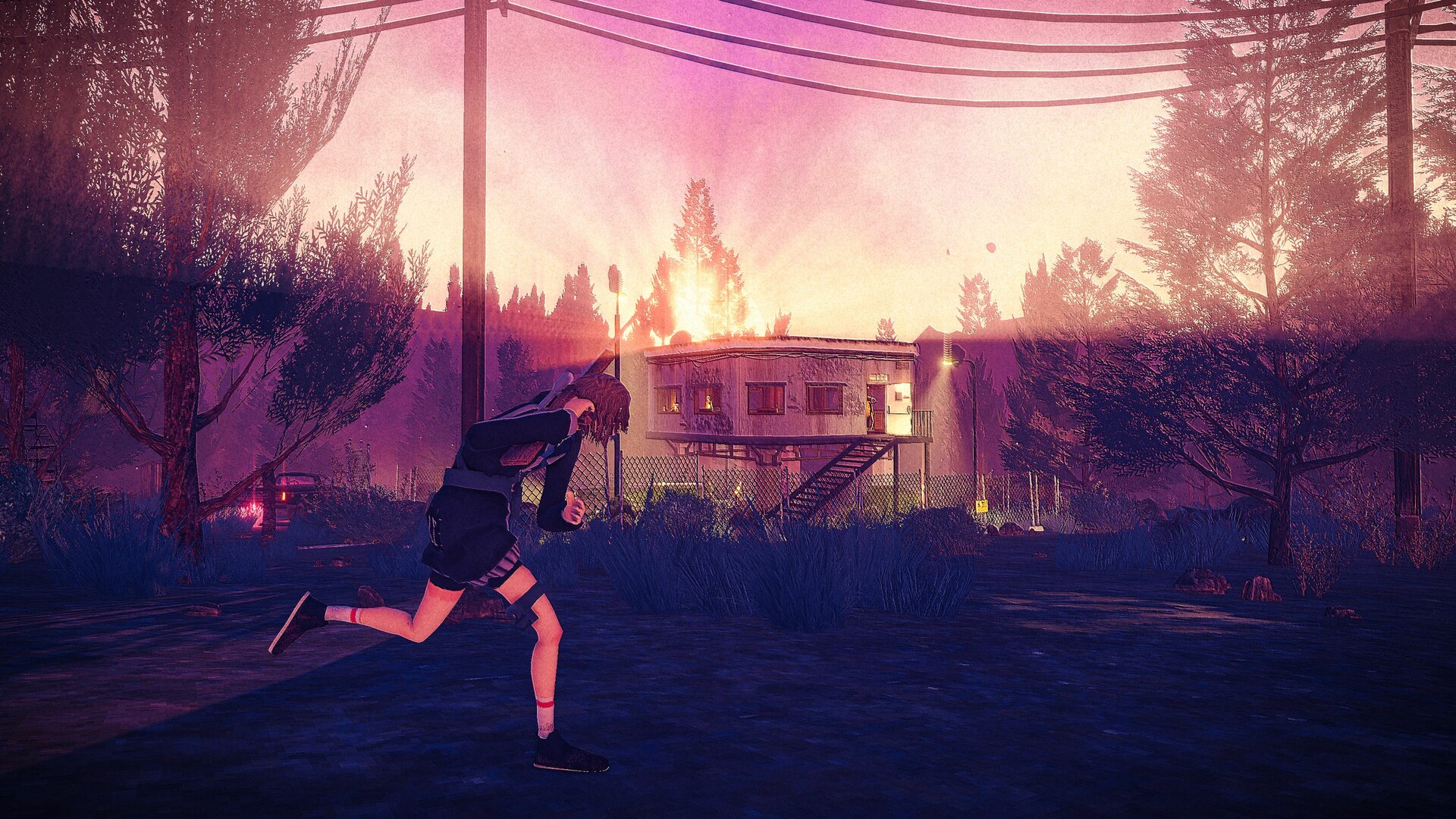In my article earlier this week about two Steam Next Fest demos of environmental games, I wrote that “cults and climate change [are] the two topics that occupy 90% of my brain.” I got my environment fix earlier this week, but Next Fest also has several demos about cults. Two that I played focus intriguingly on topics of trauma and revenge.
I played the demos for Children of the Sun and Death of a Wish, two mechanically different games that share a similar premise. Children of the Sun tasks the player to “unleash a fury of vengeance on the sinister cult that ruined your life,” according to its description. To do so, you skulk around the outside of a cult compound, targeting uninformed enemies and then guiding a single bullet around a level to kill them all. In addition to bouncing the bullet between enemies, you can shoot gas tanks to explode cars and take out multiple cultists, or change the trajectory of your bullet in mid-air to get a better vantage point on your targets. The gameplay has some big Superhot vibes, and while I found its edgy style a little much (in the demo’s opening, your character lovingly licks a rifle before basking in what seems to be a rain of blood), the harsh puzzle at its core is fascinating. It was easy to get lost in crafting the bullet’s most efficient path between enemies, and a leaderboard taunted me with the desire to replay and optimize.
Death of a Wish is a very different game, but your character has a similar motivation to Children’s protagonist. It describes its plot as “Play as Christian as he unites with new comrades to challenge the cult that raised him.” Christian seems haunted by what the cult asked of him and wrestles with his feelings of revenge, with the text saying at one point “I did all that you told me to… Now I must commit the sin no one will forgive: utter annihilation.” It takes place in a fantasy world, rather than Children’s rural compound, where Christian and a floating companion face off against supernatural enemies with a classic moveset of dodges, parries, and heavy and light attacks. You also have powers you can unleash, and a limited rewind button lets you try again if you find yourself on the losing end of an encounter. The art style is very very cool, with jagged hand-drawn lines that, while I sometimes found made it hard to tell what I was doing, give the game a distinctive look that I really loved.
Scrolling through the list of Next Fest demos, I was surprised to find these two games sharing such a similar setup of revenge against cults. But at the same time, it’s not all that surprising: religious organizations, and in particular cults, are regularly enemies in video games. To cite just a few that I’ve personally played, Dunwall’s religious order is your first foe in Dishonored; combatting a cult is the entire premise of Far Cry 5; indie game Church in the Darkness has you infiltrating what’s obviously Jonestown; Cult of the Lamb, which I’m just playing now and really enjoying, has you both fighting against one religion and forming your own, mixing dungeon runs with growing and managing your own little cult. I played Fallout 3 and Fallout: New Vegas just to experience their cult plotlines (and then, full disclosure, never picked up the games again), curious to see their takes on religion in the post-apocalypse.
My personal theory on why so many games feature cultic enemies is that, broadly speaking, they make good enemies in the same way that zombies do. If a game needs a lot of identical bad guys for you to fight, with a simple narrative justification for why they’re single-mindedly attacking you, both cultists and zombies slot right in. A harmful religious hierarchy is easy to cast as bad, and thus worth fighting, without requiring too much complicated storytelling. That hierarchy also opens the door to having both grunts and bosses: Far Cry 5, as an example, has you fight through waves of generic cultists to reach its several bosses, who, as cult leaders, can be both narratively more interesting and harder to fight. On the non-enemy side, Cult of the Lamb, while it uses its cult in really interesting ways, also uses the obedience of cult members as an easy narrative justification for why everyone does what you say.
I have long been fascinated by–to be more academic/less contentious, let’s call them “new religious movements.” Lately there’s been a surge in media about them, with podcasts and documentaries about Scientology, NXIVM, Heaven’s Gate, Twin Flames, Love Has Won, and all of the excellent work by my past colleague Jennings Brown that you should read and listen to immediately after reading this blog. This kind of work can be sensationalist and prurient, for sure–I think a fair bit of the interest in NRMs comes down to gawking at weirdos–but it’s also valuable, especially as the internet has let subcultures grow and find new members, and the current state of the world has left more people feeling isolated and desperate for connection. It’s important to be able to identify religious abuse beyond the trappings of established faiths like Christianity or Buddhism, and work like the above can give people an understanding of the warning signs and instill a healthy dose of skepticism that can keep them and their loved ones safe.
My own interest in this field comes from a lifelong fondness for meaning-making, a fascination with all the unique ways people make sense of their lives and how they live with strange or contradictory beliefs. I’ve studied the Second and Third Great Awakenings (do not get me started on the current use of the phrase) and the deeply American project of spinning up new religions, curious about why some thrive while others fade away. For every Jonestown and Heaven’s Gate out there, there are other groups that aren’t necessarily bad, just different, and while I work to temper my own tendency to be maybe too sympathetic toward them, I also think there’s something worthwhile in the way they can remind us that faith belongs to everyone, not just a handful of institutions and books from thousands of years ago.
But, more often than not, these kinds of groups cause harm, and how both individuals and society deal with that harm is a difficult and important question. Most of us probably imagine we’re too smart to fall prey to a cult, which makes identifying abuse and finding healing challenging when the stigma of abuse can mingle with the stigma of being involved in an unusual practice or belief system. Many of the podcasts and documentaries above, along with many others, do a lot of good in this regard, humanizing the experience of joining and escaping these groups and changing society’s perceptions of their survivors.
Which (finally, sorry!) brings me back to Children of the Sun and Death of a Wish. Violent revenge isn’t something we often see in real-life stories of religious or cultic abuse, though it happens. And unlike how cults are portrayed in video games, most–though not all--aren’t violent. So despite how many cultists I’ve murdered in so many video games, I was struck by the aggression of these premises. Children of the Sun’s demo doesn’t touch on how its cult ruined the protagonist’s life, and it seems militaristic in some ways, but the idea of handling religious trauma by murdering a lot of people was startling to me. Death of a Wish has fantasy vibes that remove it from the everyday, but there was something very human in the demo dialogue’s expressions of sadness and trauma that made me feel conflicted about a killing spree. It’s likely these ideas are explored more deeply in the game’s full releases, but it’s also likely that the games aren’t about cults, but–like so many other games–just use them as an easy hook for their mechanics.
And that’s fine, of course, and I enjoyed both these demos a lot. But as someone interested in their ostensible topic, I can’t help but want to dig deeply into the questions they raised for me. Can the severity of spiritual harm–something predicated on the deepest parts of a person–justify violence? Is there catharsis to be found in these kinds of games, and what use can that serve to people struggling with religious trauma? Do games that cast NRMs as enemies add to awareness about them, or do they further stigmatize their members or downplay these groups’ real dangers by making them seem like merely the stuff of fantasy? Religions are often violent while professing to be otherwise; is putting that violence in the hands of their survivors upending this power dynamic, or just indulging in its worst aspects?
These are pretty big questions to put on two game demos. But I’m glad these games got me thinking about different aspects of a topic I already spend a lot of time thinking about, even if there are no easy answers.







